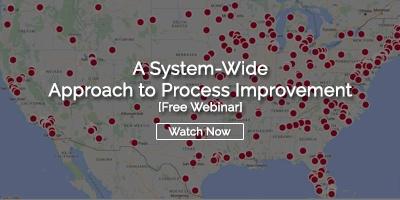
In the competitive landscape of today's business world, organizations face constant pressure to deliver superior products and services while optimizing operational efficiency. Continuous process improvement (CPI) contributes to success by providing a framework for organizations to regularly evaluate and refine their processes. This leads to cost savings and improved productivity, allowing businesses to meet or exceed customer expectations. In a marketplace where customer preferences can swiftly change, companies prioritizing CPI can quickly respond to emerging trends, innovate faster, and maintain a competitive edge. CPI ensures that organizations remain dynamic and resilient, capable of navigating challenges and seizing opportunities for sustained success in the long run.
What is continuous process improvement?
Continuous improvement is a systematic and ongoing effort to enhance organizational processes, products, or services. It involves identifying, analyzing, and implementing improvements to increase efficiency, quality, and performance. In modern business environments, CPI is crucial as it allows organizations to adapt to changing market dynamics, customer expectations, and technological advancements. Significantly, CPI fosters a culture of innovation, agility, and adaptability, enabling companies to stay competitive in a rapidly evolving business landscape.
Business process improvement has undergone significant transformations over time, reflecting technological advancements, organizational structures, and management philosophies. In the past, business processes were often manual, paper-based, and characterized by a linear and sequential nature. Workflows were rigid, with limited flexibility to adapt to changes in the business environment. Communication between departments was often siloed, leading to inefficiencies and delays in decision-making.
One major limitation in the past was the lack of technological tools and automation. Many processes relied heavily on manual labor, leading to slower execution, increased error rates, and a higher likelihood of inefficiencies. Additionally, the absence of real-time data and analytics hindered organizations from making informed decisions promptly.
With the evolution of business processes and the integration of modern technologies, organizations have overcome many of these limitations, paving the way for more agile, efficient, and data-driven operations.
Why Is Process Improvement Important?
Business process improvement is crucial for organizations seeking to enhance their efficiency, effectiveness, and overall performance. Several reasons underscore the importance of business process improvement:
It is Empowering: Improved employee engagement and relationships
Employees often appreciate working in environments where processes are well-defined and streamlined, and they contribute to their success. The process improvement methodology can improve employee morale and engagement by eliminating frustration caused by inefficient or unclear processes.
It's a Way of Life, Not an Event
We are big fans of rapid improvement events and believe that they are an important technique that can deliver breakthrough results. That said, in general, continuous improvement isn't a one-time thing. It is something that can and should happen every single day. No process can ever be considered completely improved. When one cycle of change is finished, the next can begin.
It's Educational
We're always impressed by how thoughtful our customers become about continuous process improvement and how many different methods and tools they are willing to try. No one approach is suitable for every process or for every type of problem that might come up. Sometimes, a PDSA cycle is all it takes, but A5, value stream mapping, process control charts, or a Kaizen event might be a better solution in other cases. Amazingly, when people start practicing continuous process improvement, they get much better at choosing the right tool for the job. They become willing to experiment with different approaches and learn what works best under which circumstances. In short, practicing continuous process improvement makes people smarter. What's not to love about that?
It Works
Perhaps this is all the reason one needs to get passionate about improvement. Over the years, we have seen clients make small changes that result in substantial cost savings that pay off for years. We've seen customer satisfaction improve after taking a nose dive. Customers share success stories regarding quality, safety, employee satisfaction, revenue, time to market, and cross-functional collaboration.
We Can Prove It
When customers implement KaiNexus, the average annual impact of each user is $13,000, so we know that the ROI of continuous improvement is positive. But that's another great thing about constant improvement: with the right technology in place, the impact of each improvement can be measured and shared. Unlike some other business management techniques that are hard to quantify in terms that people can get excited about, continuous process improvement can be measured against key performance indicators so that you can always keep score. That makes us happy because it creates a snowball effect—great results from improvement lead to more improvement.
Increased Efficiency and Productivity
The continuous improvement process streamlines and optimizes workflows, reducing redundant or unnecessary steps in processes. This improves efficiency, allowing organizations to accomplish tasks more quickly and with fewer resources.
Daily process improvements help identify and mitigate risks associated with business outcomes. By establishing standardized and well-documented procedures, organizations can reduce the likelihood of errors, compliance violations, and other risks.
Reduced Waste
Business process management reduces waste by identifying and eliminating unnecessary steps and redundancies in workflows, ensuring that resources are used more efficiently. Through streamlining processes, organizations can minimize the chances of errors, rework, and delays, thus reducing the overall waste of time and materials. This increased efficiency lowers operational costs and contributes to a more sustainable and environmentally friendly approach to business practices.
Reduced Costs
By identifying and eliminating inefficiencies, BPI helps organizations reduce costs associated with wasted time, resources, and materials. This cost reduction can contribute to increased profitability and competitiveness in the market.
Improved Customer Satisfaction
Efficient and effective processes often translate into better customer experiences. When organizations deliver products or services promptly, accurately, and reliably, customer satisfaction increases, leading to customer loyalty and positive word-of-mouth.
BPI methodologies often include a focus on quality management. By standardizing processes and implementing quality controls, organizations can deliver products or services with higher levels of consistency and reliability.
Shorter Cycle Time
Business process improvement reduces cycle times by optimizing and streamlining workflows, eliminating bottlenecks, and minimizing unnecessary process steps. By identifying and removing inefficiencies, organizations can expedite the completion of tasks, resulting in faster overall cycle times.
Increased Innovation and Staying Ahead of the Competition
Organizations that continuously improve their processes are better positioned to adapt to market changes, customer demands, and emerging trends. This adaptability can provide a competitive advantage over rivals that may evolve slower.
BPI initiatives are often aligned with an organization's strategic goals and objectives. By aligning processes with strategic priorities, organizations can ensure that every aspect of their operations contributes to overall success.
Allows Agility and Adaptation to Change
BPI encourages a culture of continuous improvement, fostering innovation and creativity within the organization. Employees are more likely to propose and implement innovative ideas when they see a commitment to improving processes.
The Role of BPI in Different Industries
Across all industries, organizations benefit from the relentless pursuit of process improvement. By applying proven methodologies and fostering a culture of innovation, they can achieve tangible improvements, reduce inefficiencies, and position themselves for long-term success in any sector. For example,
Manufacturing
In manufacturing, continuous process improvement is pivotal in enhancing efficiency and reducing waste. By implementing process improvement methodologies such as Total Quality Management (TQM) and Lean Manufacturing, organizations aim to optimize existing business processes, minimize defects, and increase productivity. Tangible improvements include reduced lead times, enhanced product quality, and decreased production costs. Lessons learned in manufacturing emphasize the importance of continuous monitoring, employee involvement, and the agile implementation of process improvements to stay competitive in dynamic markets.
Healthcare
Within the healthcare sector, continuous process improvement is crucial for providing high-quality patient care and optimizing resource utilization. Hospitals and clinics often apply process improvement methods to existing processes to streamline patient flow, reduce waiting times, and enhance overall service delivery. Tangible improvements may manifest as decreased patient waiting times, improved accuracy in medical records, and increased staff satisfaction. In healthcare, where patient outcomes are paramount, a patient-centric focus and a commitment to ongoing improvement lead to sustainably positive results.
Information Technology (IT)
In Information Technology, process improvement is vital for ensuring the effectiveness of systems and services. Organizations frequently utilize process improvement methods to enhance software development, project management, and IT service delivery. Improvements include faster project delivery, reduced system downtime, and increased customer satisfaction. The lessons derived from IT emphasize the need for flexibility, the integration of feedback loops, and the agile adoption of emerging technologies to refine existing processes continually.
Conclusion:
The significance of continual process improvement cannot be overstated in today's dynamic business landscape. As organizations navigate the complexities of global markets and evolving customer expectations, a commitment to enhancing business processes becomes a cornerstone for sustained success. The journey toward a culture of continual improvement process is not just a strategic choice; it is an imperative for survival and growth.
To harness the transformative power of continual process improvement, organizations need to embark on a deliberate and purposeful journey. Begin by assessing current business processes and identifying areas for improvement. Embrace proven methodologies such as Lean, Six Sigma, or Total Quality Management to guide your process improvement initiative. Foster a culture that encourages innovation and empowers employees at all levels to contribute their insights and ideas.
How KaiNexus Can Help
Technology platforms like KaiNexus are crucial in facilitating and accelerating continuous process improvement within organizations.
Online Platform: KaiNexus provides a centralized online platform where teams can collaborate on process improvement initiatives. This facilitates communication and knowledge-sharing across different departments and locations, breaking down silos.
Idea Capture and Management: Employees can easily submit ideas for improvement through the platform. This ensures that valuable insights from frontline workers are captured and considered for implementation. KaiNexus helps organizations manage and prioritize improvement ideas effectively. The platform allows for tracking idea progress, ensuring that initiatives move through various stages efficiently.
Workflow Automation: KaiNexus can automate certain aspects of the improvement process, streamlining workflows and reducing manual tasks. This leads to faster implementation of approved changes and a more efficient overall improvement process.
Data Analytics and Reporting: The platform allows organizations to track and analyze performance metrics related to improvement initiatives. This data-driven approach enables informed decision-making and the identification of areas for further optimization. KaiNexus provides real-time reporting capabilities, giving organizations instant visibility into the status and impact of ongoing process improvement efforts.
By leveraging technology platforms like KaiNexus, organizations can overcome many challenges associated with manual and fragmented approaches to continuous process improvement. Technology empowers organizations to harness the collective intelligence of their workforce, drive efficiency, and foster a culture of innovation and adaptability.
Want to explore the next phase of your continuous process improvement journey? Our team is standing by to help.



Add a Comment